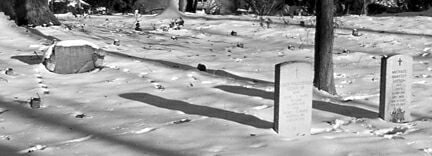The Litton Cemetary
Opening the book on the family and their times

What's all this then?
Off to one side of Rockville's Tweed Park, is the cemetery belonging to one of the earliest families of the area, the Littons. If you look them up, you may find the name spelled Litton, Litten, Lutton, Letton, Liton, or Lytton, (since literacy was less common during the colonial period, spelling was not as important as it is today). The stones of Caleb Litton Sr. (April 24, 1678 – Aug. 4, 1763) and Michael Litton (April 4, 1740 – Sept. 10, 1819) are modern reproductions, made when a local scout troop cleaned and reconstructed the site. Those two stones are probably not over the actual burial sites, but placed close to the path so we can read them easily.
The third visible stone is an original that has been broken off just above the dates (May 12, 1764 – June 5, 1802). This is the grave of John L. Summers, who was one of Caleb's grandsons. There are another eighteen to twenty, unreadable fragments of gravestones that show us where others were buried.
Twinbrook cemetery is historically interesting for more than simply being, perhaps, the second oldest surviving cemetery in the Rockville area (only Rockville Cemetery, which is a few blocks from us on Baltimore Road, is definitely known to be older). It is also the last resting place of Thomas Linsted and John L. Summers, both of whom were related to the Littons, and who were signers of the “Oath of Fidelity and Support” to the fledgling state of Maryland, but more about that in a moment.
How to get there 
From Meadow Hall, cross Twinbrook Parkway at the lower crossing, turn left and walk one block. At Marshall Avenue turn right and walk one block. At Tweed Street, turn left and keep your eyes open for an egress between 1705 and 1707. Turn right and go up the steps. This will lead you to a lightly wooded area with a wood-chip path. The cemetery is clearly visible ahead and slightly to the left of you.
The two modern stones and the marble brick delineations are approximations of the burial locations, as only one original stone and some fragments have survived to give us any idea of the grave sites.
Who is Buried in the Twinbrook Cemetery? 
Not only did the Littons have a variety of spellings of their name, but the cemetery itself has gone through several names as well. Throughout the years it has been known as the Litton Family Cemetery, the Summers Cemetery, the Willow Tree Graveyard, and finally as the Twinbrook Cemetery.
According to family history and an article in the April, 1917 National Genealogical Society Quarterly , the cemetery is the site for the burial of Caleb Litton the elder, Grace Litton (his wife), and Michael Litton (their son). As the family grew, the cemetery began to include those related through marriage, such as John L. and J. N. Summers (grandsons of Caleb the elder, and inheritors of the Litton property), Mary & Charles Crabb, Thomas Linstead, and Ann Marie Wilson (born Litton). Presumably, Ann Marie's husband is also there. Since John L. Summers is in the cemetery, I would guess that his parents, Grace Litton Summers and her husband Benjamin are also there. The fact that the cemetery holds so many people is a reasonable argument that the Littons were a fairly wealthy and influential family.
What was the Oath of Fidelity and Support?
In 1774, as a result of the Boston Tea Party, the British blockaded the colonial port of Boston. In lower Frederick County*, a group of landowners met at Hungerford's Tavern** to draft the Hungerford Resolves, condemning the British actions and supporting the Boston protesters. The resolves were presented to the Maryland legislature and published for public notice. Five days later, the legislature met and soon agreed to stop importing goods from England and (if they could convince Virginia and North Carolina to go along with them) to stop exporting tobacco to England. The citizens of Maryland even had their own “tea party” in the Annapolis Harbor and many decided to stop buying and drinking tea altogether.
Even though Maryland rebelled against English rule, many citizens still supported the Crown. When war finally broke out, all male citizens were required by the Maryland Assembly to sign an Oath of Fidelity and Support (a pledge to support the efforts of the colonies to break away from England) if they wished to be able to vote and continue to do business in Maryland. By the end of the war, nearly ten percent of Maryland's population had served in the colonial army and Maryland was part of the new United States of America.
_____________________________________________________________________________________
* A quick and dirty history would show that Maryland was part of Virginia until 1632. In 1695, Prince George's County was formed. It included the modern county of Prince George's, and all counties west of there, as well as what would become Washington DC. In 1719, the first land patent in the area that would become Rockville was granted to Arthur Nelson (“Valentine's Garden”) and in 1722 Caleb Litton was granted the lands called "Oatry". 1722 also saw the official naming of the Rockville area as The Potomack Hundred. In 1748 Frederick County was formed from the western end of Prince George's county. Finally, Frederick County was broken into the counties we know as Washington, Frederick and Montgomery in 1776.
** Rockville has been known by many names during its history, often simply as the name of the most prominent business in the area. Originally, the area was a junction where two major trade roads crossed. The larger of the roads was a North-South Indian track that eventually grew to become the major colonial trade route (The Great Road) that ran from Frederick Town to George Town. That path is now known as Route 355, or Rockville Pike in our area. The other trade road led from the seaport of Bladensburg to the Monocacy River. In 1722, the area was officially named The Potomack Hundred (a “hundred” was a measure of land that could support 100 people). A new world “hundred” tended to have a lot more land than its British counterpart.
Some of Rockville's early names were; Martin's Store, Mr. Daly's Tavern, Owen's Ordinary, Hungerford Tavern, Montgomery Court House (1776, when it became the official county seat), and Williamsburgh (1784). According to the Mayor's office, it also went by the names Muggle's Crossing and Montgomery Village. It wasn't called Rockville until 1803. In 1860 it was incorporated by the Maryland General Assembly as the town of Rockville. While there is speculation that the town was named after Rock Creek, no one knows for sure where the name came from.
To learn more about the Litton family, click here
My thanks go Blair Ewing and Peerless Rockville (especially Eileen McGuckian) for filling in the many gaps in my knowledge.
Dave Scalzi
